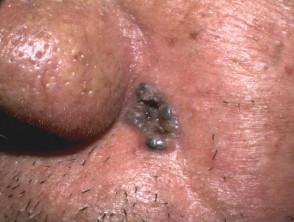Introduction
Basal cell carcinoma (BCC) is the most common malignancy in people of European descent and is particularly prevalent in Australia and New Zealand. The exact cause of BCC is unknown, but environmental and genetic factors predispose patients to BCC.
Recently, there have been advances in the understanding of the molecular genetics of inherited and sporadic BCC. Malfunctioning of the hedgehog (HH) signalling pathway and gene mutations increase the risk of BCC.
Basal cell carcinoma
What is the hedgehog signalling pathway?
The hedgehog signalling pathway (HH pathway) influences the differentiation of various tissues during fetal development.
In adults, it continues to function in the regulation of cell growth and differentiation.
Malfunctioning of this pathway is associated with human malignancy, including BCC.
How does the HH signalling pathway work?
The hedgehog gene in the HH pathway codes for an extracellular protein, the sonic hedgehog (SHH) protein. SSH binds to the cell membrane receptor complex to start a cascade of cellular events leading to cell proliferation.
The cell membrane receptor complex consists of two proteins:
- Patched (PTCH)1 protein, the ligand-binding component of the hedgehog receptor complex in the cell membrane
- Smoothened (SMO) protein, responsible for transducing hedgehog signalling to downstream genes.
In the resting state, PTCH1 holds SMO in an inactive state, thus inhibiting signalling to downstream genes.
In the active state:
- SHH binds to PTCH1
- PTCH1 inhibition of SMO is released
- The hedgehog pathway is activated through a series of interacting proteins including suppressor of fused (SUFU) protein, leading in turn to the activation of transcription factors and the expression of target cell cycle regulator genes.
What happens when the HH pathway malfunctions?
Malfunctioning of the HH pathway is associated with human malignancy, including BCC.
The normal functioning of the HH pathway can be disrupted because of mutations in the genes coding for the PTCH1, PTCH2, SMO or SUFU proteins.
PTCH1 gene mutations prevent PTCH1 protein from binding to SMO.
Unbound SMO allows unregulated cell growth through activation of the following:
- Transcription factors (proteins that bind to specific DNA sequences and control the flow of genetic information from DNA to RNA) GLI1 (glioma-associated oncogene 1; also called zinc finger protein) and GLI2
- Cell proliferation genes (cyclin D, cyclin E, myc), and
- Regulators of the process involving the growth of new blood vessels (angiogenesis).
Major genes increasing BCC risk
Mutations in the PTCH1, PTCH2, SMO and SUFU genes predispose patients to BCC.
Patients with basal cell naevus syndrome (Gorlin syndrome) are born with an inherited mutation of one allele of the PTCH1 gene. The mutation leads to an autosomal dominant syndrome of cancer predisposition. The remaining good allele can undergo mutation through UV radiation exposure in one lifetime, such that these patients can develop BCC tumours at an earlier age than the general population.
- Up to 70% of people with sporadic BCC without basal cell naevus syndrome have patched PTCH1 gene mutations as a result of UV radiation exposure.
- In 10–20% of patients with sporadic BCC, mutations in the SMO gene allow for unregulated signalling of tumour growth.
- A small number of sporadic BCC patients have mutations in the PTCH1 homologue PTCH2 (a variant of the PTCH1) and SUFU.
Other genes of importance in BCC risk
Mutations in the tumour suppressor gene P53 and the melanocortin-1 receptor (MCR1) gene may be involved in the development of sporadic BCC.
P53 gene
- P53 encodes the protein P53 which has been termed ‘guardian of the genome’.
- The P53 protein functions to sense genotoxic injury and arrest cell division allowing DNA repair to occur before replication.
- In the case of extensive DNA damage, it induces apoptosis (cell death) to eliminate defective and potentially malignant cells.
- Mutations of P53 occur in a wide variety of human cancers including BCC.
- In 44–100% of BCC patients, mutations are found in P53, most likely as a result of exposure to UV radiation.
- Arsenic exposure is well known to contribute to BCC formation and is thought to occur through DNA methylation of genes in the P53 pathway.
Melanocortin-1 receptor gene
- The MC1R gene codes for the melanocortin-1 receptor gene (MC1R) protein expressed on the surface of melanocytes.
- Upon stimulation by the α-melanocyte-stimulating hormone (αMSH), it leads to the production of melanin in the skin and hair.
- If the MC1R gene is a wild type, eumelanin is produced leading to tanned skin and dark hair.
- The MC1R red hair colour (RHC) variants lead to the production of pheomelanin and the RHC phenotype: fair skin, red hair, freckles and a higher susceptibility to melanoma and non-melanoma skin cancers.
- Various studies confirm the association of MC1R variants with BCC risk and show that a fair complexion in addition to MC1R variants greatly increases this risk.
Miscellaneous genes
Mutations/variants of the following genes may predispose patients to sporadic BCC:
- Glutathione-S-transferase gene (cellular glutathione-S-transferases are involved in the protection against oxidative stress on the skin)
- P 450 CYP enzyme gene (cytochrome P450 enzymes are involved in detoxification of numerous xenobiotics including carcinogenic components of tobacco smoke)
- DNA repair gene XRCC3
- Cyclin-dependent kinase inhibitor genes CDKN2A and CDKN2B
- Basal keratinocyte keratin K5 gene
- BRM gene.
Hedgehog antagonist for advanced BCC
Vismodegib (trade name Erivedge™) is a hedgehog pathway inhibitor that was approved in 2012 for the treatment of advanced and metastatic BCC. In 2015, sonidegib was also approved for the treatment for advanced basal cell carcinoma.
Other therapies targeting molecules of the HH signalling pathway are under development.
